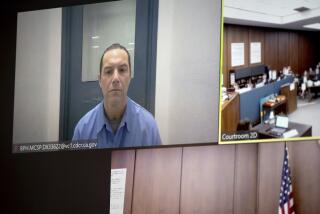Testimony on Lab Barred by Judge
- Share via
O.J. Simpson’s defense team will not be able to present key testimony from a DNA scientist who was prepared to tell jurors that the Los Angeles Police Department crime lab was a “cesspool of contamination” sullied by sloppy evidence handling, the trial judge ruled Wednesday.
Microbiologist John Gerdes will be allowed to testify about problems he detected in the LAPD’s analysis of specific pieces of evidence, such as bloodstains on the steering wheel of Simpson’s Ford Bronco. But he cannot offer his more general assessment of the LAPD lab, Superior Court Judge Hiroshi Fujisaki ruled.
In Simpson’s criminal trial, Gerdes issued a devastating critique of the lab, saying it was the worst of 23 DNA labs he had visited nationwide and that it should be shut down. Gerdes reached that conclusion after analyzing the LAPD’s performance on various DNA proficiency tests. The contamination problem, he testified, was “persistent and substantial” because it showed up “month after month” in his study.
To the defense team’s obvious consternation, Fujisaki ruled Gerdes’ study of general LAPD practices irrelevant to the Simpson civil case. The ruling was consistent with Fujisaki’s long-standing demand that both sides stay focused on the actual evidence instead of spinning off on tangents.
Analysts termed the ruling a setback for the defense--but predicted that Simpson’s team would find ways to get the contamination issue before jurors.
Gerdes is scheduled to take the stand today. On Wednesday, the defense presented a grab bag of witnesses: a detective, a criminalist, a videographer, and three people who spoke with O.J. Simpson on a redeye flight to Chicago just hours after the murders of Nicole Brown Simpson and Ronald Lyle Goldman.
The airplane witnesses testified that Simpson was cordial, engaged in casual chitchat and even signed autographs during the flight. All said they observed his hands. None saw any cuts or bleeding. On cross-examination, however, plaintiffs’ attorneys pointed out that none of the witnesses specifically studied Simpson’s hands. The plaintiffs also sought to cast doubt on the witnesses’ memories by asking two of them what Simpson wore that night. The two described completely different outfits--and neither description matched what Simpson says he wore.
Perhaps the plaintiffs’ biggest victory came when they were questioning LAPD videographer Willie Ford Jr.
Ford became a star of the defense case in the criminal trial when he testified that he did not see any socks on the carpet in front of Simpson’s bed while videotaping the room about 4:20 p.m. the day after the murders. The defense contends that Ford did not see the socks because they were never there--at least not until someone planted them for LAPD criminalists to find and collect about 20 minutes later.
*
But plaintiffs’ attorney Peter Gelblum appeared to deflate that theory with one question. He pointed out that Ford’s job was to videotape Simpson’s property after the evidence was collected, to document that the LAPD did not break or steal anything.
“So the socks weren’t there because they’d already been picked up?” he asked.
“Yes, sir,” Ford answered.
Also Thursday, lead defense attorney Robert C. Baker wrapped up his fierce questioning of retired LAPD homicide Det. Tom Lange. Through his questions, Baker suggested that former Det. Mark Fuhrman had roamed across Simpson’s property for 30 minutes, unaccompanied and unmonitored--and had ample opportunity to plant a bloody glove.
Lange agreed that Fuhrman was out of his sight at times.
After suggesting that the glove was planted on Simpson’s estate, Baker accused Lange of ordering a criminalist to bring it to the murder scene to compare it with another bloodied leather glove lying near the bodies. Lange repeatedly denied that allegation.
That account directly contradicted testimony from criminalist Dennis Fung. Fung told jurors that he reluctantly brought the glove into the crime scene at Lange’s direction.
More to Read
Sign up for Essential California
The most important California stories and recommendations in your inbox every morning.
You may occasionally receive promotional content from the Los Angeles Times.













